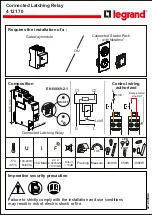
68
6
F
2
S
0
8
3
4
The overcurrent backup protection can provide a fail-safe function by assigning the PLC signals
OC-
∗
_FS and OCI-
∗
_FS to an output of relay element, etc. The PLC signals OC-
∗
_FS and
OCI-
∗
_FS are assigned to “1” (Signal No. =1) as default.
Tripping by each element can be disabled by the scheme switches [OCBT], [OCIBT], [EFBT]and
[EFIBT], and also can be disabled by the binary input signals (PLC signals) OC_BLOCK,
OCI_BLOCK, EF_BLOCK and EFIBLOCK. The EF element issues an alarm for the backup trip
for earth fault. The alarm can be disabled by the scheme switch [EFBTAL]. The OC and EF
protections can trip instantaneously by PLC signal OC_INST_TP and EF_INST_TP.
2.4.5.1 Inverse Time Overcurrent Protection
In a system in which the fault current is mostly determined by the fault location, without being
greatly affected by changes in the power source impedance, it is advantageous to use inverse
definite minimum time (IDMT) overcurrent protection. Reasonably fast tripping can be obtained
even at a terminal close to the power source by using inverse time characteristics. In the IDMT
overcurrent protection function, one of the following three IEC-standard-compliant inverse time
characteristics and one long time inverse characteristic is available.
•
standard inverse IEC 60255-3
•
very inverse
IEC 60255-3
•
extremely inverse IEC 60255-3
The IDMT element has a reset feature with definite time reset.
If the reset time is set to instantaneous, then no intentional delay is added. As soon as the
energizing current falls below the reset threshold, the element returns to its reset condition.
If the reset time is set to some value in seconds, then an intentional delay is added to the reset
period. If the energizing current exceeds the setting for a transient period without causing tripping,
then resetting is delayed for a user-definable period. When the energizing current falls below the
reset threshold, the integral state (the point towards operation the it has travelled) of the timing
function (IDMT) is held for that period.
This does not apply following a trip operation, in which case resetting is always instantaneous.
Setting
The following table shows the setting elements necessary for the inverse time overcurrent backup
protection and their setting ranges.
Element Range
Step Default Remarks
OCI
0.5 - 25.0 A
0.1 A
10.0 A
( 0.10 - 5.00 A
0.01 A
2.00 A) (*)
TOCI
0.05 - 1.00
0.01
0.50
OCI time setting
TOCIR
0.0 – 10.0 s
0.1 s
0.0 s
OCI definite time reset delay
[MOCI]
Long/Std/Very/Ext
Std
OCI inverse characteristic selection
[OCIBT]
ON/OFF
ON
OCI backup protection
EFI
0.5 - 5.0 A
0.1 A
5.0 A
Earth fault EFI setting
( 0.10 - 1.00 A
0.01 A
1.00 A) (*)
TEFI
0.05 - 1.00
0.01
0.50
EFI time setting
TEFIR
0.0 – 10.0 s
0.1 s
0.0 s
EFI definite time reset delay
[MEFI]
Long/Std/Very/Ext
Std
EFI inverse characteristic selection
[DEFI]
ON/NOD/F/R
OFF
EFI directional control
(*) Current values shown in the parentheses are in the case of 1 A rating. Other current values are in
the case of 5 A rating.
The scheme switches [MOCI] and [MEFI] are used to select one of the four inverse time
www
. ElectricalPartManuals
. com
Summary of Contents for GRZ100-211B
Page 323: ... 322 6 F 2 S 0 8 3 4 w w w E l e c t r i c a l P a r t M a n u a l s c o m ...
Page 343: ... 342 6 F 2 S 0 8 3 4 w w w E l e c t r i c a l P a r t M a n u a l s c o m ...
Page 383: ... 382 6 F 2 S 0 8 3 4 w w w E l e c t r i c a l P a r t M a n u a l s c o m ...
Page 395: ... 394 6 F 2 S 0 8 3 4 w w w E l e c t r i c a l P a r t M a n u a l s c o m ...
Page 411: ... 410 6 F 2 S 0 8 3 4 w w w E l e c t r i c a l P a r t M a n u a l s c o m ...
Page 423: ... 422 6 F 2 S 0 8 3 4 w w w E l e c t r i c a l P a r t M a n u a l s c o m ...
Page 443: ... 442 6 F 2 S 0 8 3 4 w w w E l e c t r i c a l P a r t M a n u a l s c o m ...
Page 451: ... 450 6 F 2 S 0 8 3 4 w w w E l e c t r i c a l P a r t M a n u a l s c o m ...
Page 459: ... 458 6 F 2 S 0 8 3 4 w w w E l e c t r i c a l P a r t M a n u a l s c o m ...
Page 463: ...w w w E l e c t r i c a l P a r t M a n u a l s c o m ...














































